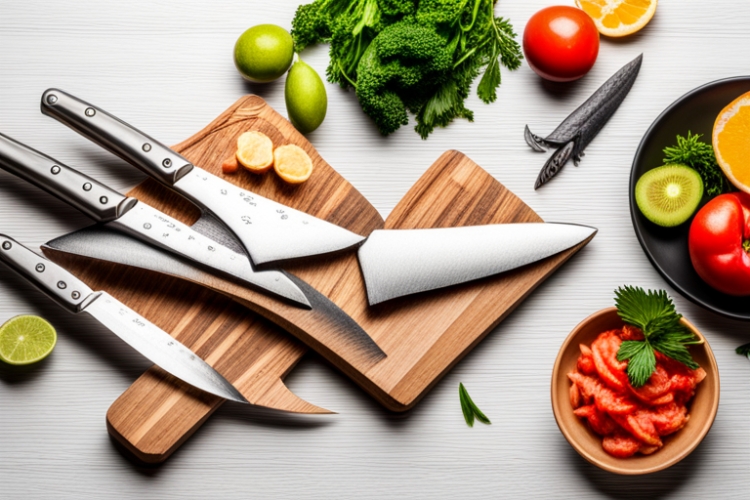When it comes to kitchen knives, you deserve the very best. But with so many options available in the market, finding the perfect knife that meets your needs can be a daunting task. Stainless steel knives have long been touted as a top choice for professional chefs and avid home cooks alike. But are they truly worth the investment? In this comprehensive review, we will delve into the world of stainless steel knives and provide you with all the essential information you need to make an informed decision.
Investing in stainless steel knives can greatly enhance your culinary experience. Whether you are a professional chef or a home cook, having high-quality knives is essential for efficient and precise cutting. In this section, we will explore the effects of investing in stainless steel knives and discuss important factors to consider before making the investment.
Exploring the effects of investing in stainless steel knives
Investing in stainless steel knives can have a significant impact on your cooking experience. Stainless steel is known for its durability, which means that these knives have a longer lifespan compared to other materials. With proper care and maintenance, stainless steel knives can last for years, saving you money in the long run.
Another effect of investing in stainless steel knives is their sharpness. Stainless steel is known for its ability to hold a sharp edge, which means that these knives will stay sharper for longer periods of time. This not only improves the overall cutting performance, but it also reduces the risk of accidents that can occur due to dull blades.
Furthermore, stainless steel knives offer better hygiene compared to other materials. Stainless steel is non-porous, making it resistant to bacteria and other microbes. This makes these knives easier to clean and reduces the risk of cross-contamination while cooking.
Important factors to consider before making the investment
Before investing in stainless steel knives, there are some important factors to consider. Firstly, it is important to determine your specific needs and preferences. Consider the type of cooking you do, the tasks you frequently perform, and the types of ingredients you work with. This will help you choose the right types and sizes of knives for your kitchen.
Another factor to consider is your budget. Stainless steel knives come in a wide range of prices, so it is essential to set a budget that aligns with your financial capabilities. While it is tempting to opt for cheaper options, investing in higher-quality knives will pay off in terms of durability and performance.
Additionally, it is important to research and compare different brands and models of stainless steel knives. Read reviews, check the reputation of the manufacturer, and consider the warranties and customer support offered. This will help you make an informed decision and ensure that you are investing in a reliable and reputable product.
It is definitely worthwhile to invest in stainless steel knives if you want to improve your cooking skills. By understanding the effects of such an investment and considering important factors beforehand, you can make a wise decision that will benefit you in the kitchen for years to come.Comparing the pros and cons of stainless steel knives
When it comes to choosing the perfect knife for your kitchen, it's important to consider all the factors to make an informed decision. Stainless steel knives have long been a popular choice among professional chefs and home cooks alike. However, like any other type of knife, they have their own set of advantages and disadvantages. In this section, we will compare the pros and cons of stainless steel knives to help you make the right choice for your culinary needs.
The Pros
Stainless steel knives offer several benefits that make them stand out from other types of knives:
- Corrosion Resistance: One of the primary reasons stainless steel knives are preferred is their ability to resist corrosion. Stainless steel contains chromium, which forms a protective layer on the blade, preventing rust and discoloration. This makes these knives highly durable and long-lasting.
- Low Maintenance: Another advantage of stainless steel knives is that they require minimal maintenance. Unlike carbon steel knives, which can oxidize and need frequent oiling, stainless steel knives are relatively easy to clean and maintain. They are also dishwasher safe in most cases, making them convenient for everyday use.
- Cost-Effective: Stainless steel knives are often more affordable compared to knives made from other materials like high-carbon steel or ceramic. This makes them a popular choice for home cooks who want a reliable knife without breaking the bank.
The Cons
While stainless steel knives have many benefits, they also have a few drawbacks that you should consider:
- Limited Edge Retention: Stainless steel knives are known to have slightly lower edge retention compared to high-carbon steel knives. This means that while they are easy to sharpen, they may require more frequent sharpening to maintain their cutting performance.
- Prone to Stains and Scratches: Despite being corrosion resistant, stainless steel knives can still develop stains or scratches over time, particularly if not properly cared for. These imperfections can affect the aesthetics of the knife but usually do not impact its performance.
- Not Ideal for Precision Work: Due to their relatively softer nature compared to other types of knives, stainless steel knives may not be the best choice for tasks that require extreme precision, such as filleting delicate fish or thinly slicing sushi. For such tasks, knives made from harder materials like high-carbon steel or ceramic may be more suitable.
Factors to consider when weighing the pros and cons
Choosing the right knife for your needs involves considering various factors. Here are some key points to keep in mind when weighing the pros and cons of stainless steel knives:
- Intended Use: Think about the specific tasks you'll be using the knife for. If you primarily perform general kitchen tasks like chopping vegetables, mincing garlic, or slicing meat, a stainless steel knife should serve you well. However, if you have specialized needs that require extreme precision, you may want to explore other knife materials.
- Budget: Consider your budget when deciding on a knife. Stainless steel knives generally offer good value for money, but if you have a higher budget, you may want to explore knives made from premium materials.
- Maintenance Preference: Think about how much time and effort you're willing to invest in knife maintenance. If you prefer low-maintenance options, stainless steel knives are a great choice due to their corrosion resistance and easy cleaning.
By carefully weighing the pros and cons of stainless steel knives and considering these important factors, you can make an informed decision that suits your specific culinary needs and preferences.
When it comes to equipping your kitchen with reliable and durable knives, stainless steel is the way to go. However, with the wide variety of options available in the market, selecting the right stainless steel knife can be a daunting task. To help you make an informed decision, we have put together this comprehensive guide on how to choose the perfect stainless steel knife for your needs.
Step-by-Step Guide for Selecting the Right Stainless Steel Knife
The process of selecting a stainless steel knife can be simplified by following these steps:
- Define your purpose: Determine the specific tasks you will be performing with the knife. Are you looking for a multipurpose chef's knife or specialty knives for specific purposes such as filleting fish or slicing bread? Understanding your purpose will help you narrow down your options.
- Consider the blade material: Look for knives made from high-quality stainless steel, as it offers excellent corrosion resistance and retains sharpness for longer. Common stainless steel types for kitchen knives are 420, 440, and VG-10. Each has its advantages, so compare their properties to find the one that suits your needs best.
- Evaluate the blade shape: The shape of the blade affects the knife's functionality. For tasks that require precision and control, such as mincing herbs, a knife with a narrow and pointed blade, like a paring knife, would be ideal. On the other hand, a knife with a broader and curved blade, like a chef's knife, is versatile and suitable for multiple tasks.
- Assess handle comfort and design: The handle should provide a comfortable grip and be ergonomically designed to reduce strain during prolonged use. Look for handles made from durable materials like wood, plastic, or stainless steel. Consider the weight and balance of the knife to ensure a seamless cutting experience.
- Check for additional features: Some stainless steel knives come with additional features like a bolster for better balance and finger protection, a full tang for added strength, or a non-slip handle for improved safety. These features can enhance the functionality and longevity of the knife.
Key Considerations While Making the Choice
When choosing a stainless steel knife, keep the following factors in mind:
- Price: While high-quality stainless steel knives often come at a higher price, they are a worthwhile investment due to their longevity and performance. However, ensure that the knife fits your budget while meeting your requirements.
- Maintenance: Consider the maintenance requirements of the knife. Stainless steel knives are generally low maintenance, but some may require regular sharpening or special cleaning instructions.
- Brand reputation: Look for reputable brands known for their quality craftsmanship and customer satisfaction. Research customer reviews and seek recommendations to find a brand that consistently delivers reliable stainless steel knives.
- Warranty: Check if the knife comes with a warranty or guarantee. A warranty ensures that you are protected against defects or damage, providing you with peace of mind.
By following this step-by-step guide and considering the key factors mentioned above, you can confidently choose the perfect stainless steel knife that meets your requirements and elevates your culinary experience.
Conclusion: Are Stainless Steel Knives Worth the Investment? A Comprehensive Review
Following an extensive examination of stainless steel knives, it can be said with confidence that the investment is well worth it. These knives offer a myriad of benefits that make them a smart choice for any culinary enthusiast or professional chef. Their exceptional durability, resistance to corrosion, and ability to maintain a sharp edge are unmatched by any other knife material. Additionally, stainless steel knives provide ease of maintenance and cleanliness, ensuring hygiene and food safety. While the initial cost may be higher compared to other knife options, their longevity and performance make them a wise investment in the long run. Whether you are slicing, dicing, or mincing, stainless steel knives are sure to enhance your cooking experience and deliver precise results. Make your kitchen complete with the versatile and enduring stainless steel knives, and elevate your culinary skills to new heights.
NWS



